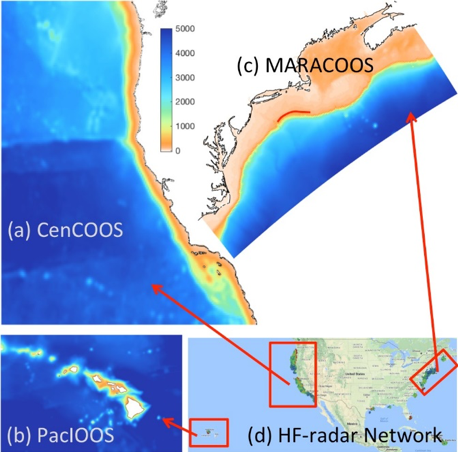
Model domains and bathymetry for the ROMS 4D-Var data-assimilative near real-time analysis-forecast systems operated for (a) CeNCOOS, (b) PacIOOS and (c) MARACOOS. In (c) the section colored red is the target site chosen for the observation impact calculations in section 2.6.3. (d) HFRNet national map showing the HF-radar coverage for the three IOOS RA systems. The Hawaii domain shown assimilates data from 9 HF- radar sites.
The University of California Santa Cruz (UCSC) Department of Ocean Sciences was awarded a 3-year grant to transition a Real-time Monitoring of the Impact of Observing Systems on Ocean Analysis-Forecast Systems in Support of U.S. IOOS into Operations. The current ocean observing system comprises satellite measurements of surface properties such as sea surface temperature, sea surface height, and ocean color, as well as in situ observing systems, many of which are managed and maintained by U.S. IOOS and its Regional Associations (RAs). In partnership with U.S. IOOS’ Central and Northern California Coastal and Ocean Observing System, Pacific Islands Ocean Observing System and Mid-Atlantic Regional Association of Coastal and Ocean Observing Systems and with the University of Hawaii, Rutgers University, and RPSGroup Inc./Applied Science Associates this project will focus on advancement of the Regional Ocean Modeling System 4-dimensional variational data assimilation system’s diagnostic tools to assess the impact of IOOS’ observations on analysis and forecasts that address ocean, coastal, and Great Lakes observing, product, development, and data management challenges to support future enhancements to IOOS. This project will provide a new ability to analyze the observing assets of the IOOS system in a new and unique way that will enable prioritization of observing system assets and technologies toward improving overall operational efficiency of IOOS investments.
The Year 1 total for this award is $414,855.
 Official websites use .gov
A .gov website belongs to an official government organization in the United States.
Official websites use .gov
A .gov website belongs to an official government organization in the United States.
 Secure .gov websites use HTTPS
A lock or https:// means you’ve safely connected to the .gov website. Share sensitive information only on official, secure websites.
Secure .gov websites use HTTPS
A lock or https:// means you’ve safely connected to the .gov website. Share sensitive information only on official, secure websites.
